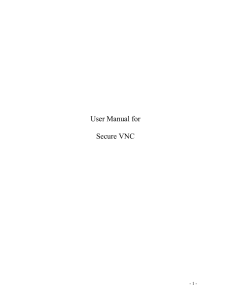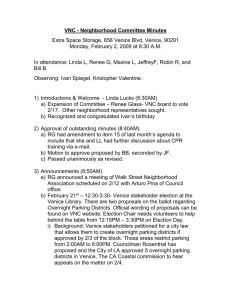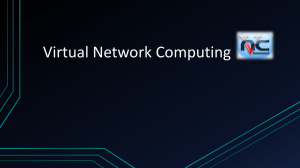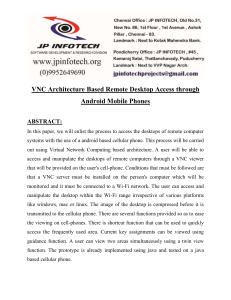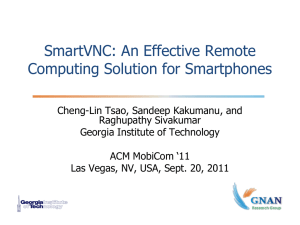Virtual Network Computing - The Computer Laboratory
advertisement
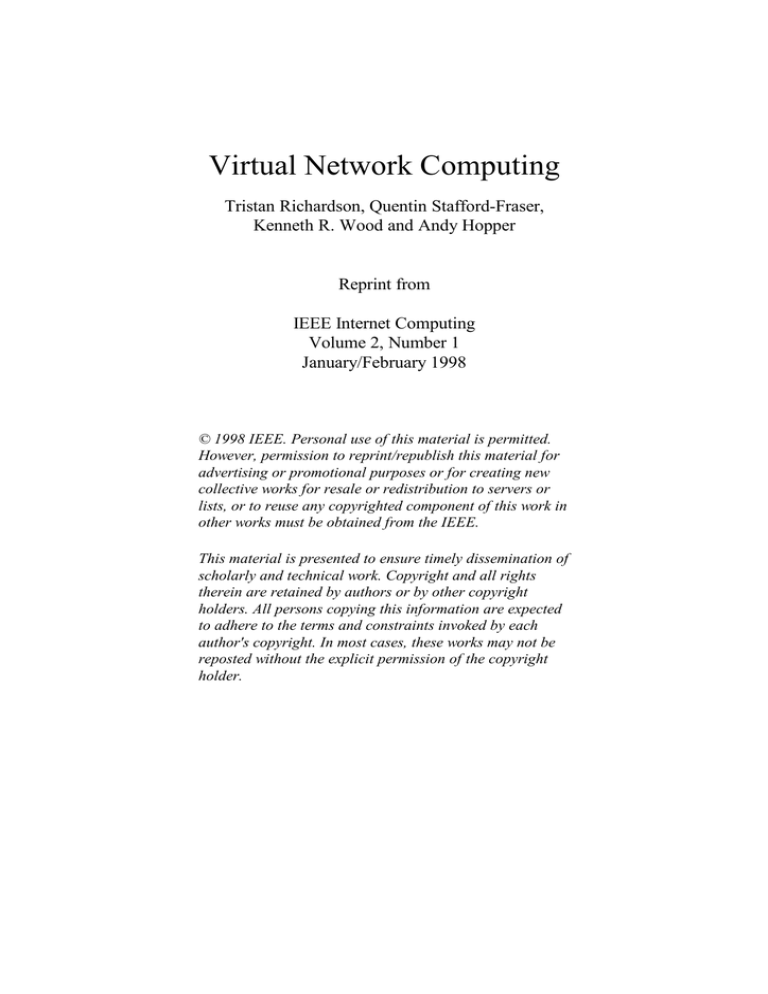
Virtual Network Computing Tristan Richardson, Quentin Stafford-Fraser, Kenneth R. Wood and Andy Hopper Reprint from IEEE Internet Computing Volume 2, Number 1 January/February 1998 © 1998 IEEE. Personal use of this material is permitted. However, permission to reprint/republish this material for advertising or promotional purposes or for creating new collective works for resale or redistribution to servers or lists, or to reuse any copyrighted component of this work in other works must be obtained from the IEEE. This material is presented to ensure timely dissemination of scholarly and technical work. Copyright and all rights therein are retained by authors or by other copyright holders. All persons copying this information are expected to adhere to the terms and constraints invoked by each author's copyright. In most cases, these works may not be reposted without the explicit permission of the copyright holder. . F E A T U R E VIRTUAL NETWORK COMPUTING VNC is an ultra-thin T RISTAN R ICHARDSON , Q UENTIN S TAFFORD -F RASER , K ENNETH R. W OOD , AND A NDY H OPPER * The Olivetti & Oracle Research Laboratory client system based on a simple display protocol that is platformindependent. It achieves mobile computing without requiring the user to carry any hardware. T he so-called network computer (NC) aims to give users access to centralized resources from simple, inexpensive devices. These devices act as clients to more powerful server machines that are connected to the network and provide applications, data, and storage for a user’s preferences and personal customizations. We have taken this idea a stage further. In the virtual network computing (VNC) system, server machines supply not only applications and data but also an entire desktop environment that can be accessed from any Internet-connected machine using a simple software NC. Whenever and wherever a VNC desktop is accessed, its state and configuration (right down to the position of the cursor) are exactly the same as when it was last accessed. In contrast to many recent Internet applications, which have focused on giving users access to resources located anywhere in the world from their home computing environments, VNC provides access to home computing environments from anywhere in the world. Members of the Olivetti & Oracle Research Laboratory (ORL) use VNC to access their personal Unix and PC desktops from any office in our Cambridge building and from around the world on whatever computing infrastructure happens to be available—including, for example, public Web-browsing terminals in airports. VNC thus provides mobile computing without requiring the user to carry any device whatsoever. In addition, VNC allows a single desktop to be accessed from several places simultaneously, thus supporting appli*Andy Hopper is also affiliated with Cambridge University Engineering Department. 1089 -7801/ 9 8 /$10.00 ©1998 IEEE http://computer.org/internet/ JANUARY • FEBRUARY 1998 33 . M O B I L E C O M P U T I N G THIN CLIENTS The Virtual Networking Computing (VNC) system is a thinclient system. Like all such systems, it reduces the amount of state maintained at the user’s terminal. VNC viewers are exceedingly thin because they store no unrecoverable state at the endpoint. This contrasts with systems like X Windows, and allows arbitrary disconnection and reconnection of the client with no effect on the session at the server. Since the client can reconnect at a different location—even on the other side of the planet—VNC achieves mobile computing without requiring the user to carry computing hardware. Of course, VNC is not the only thin-client system. Others include those built around the Citrix ICA protocol (for example, Citrix’s Winframe and Insignia Solutions’ Ntrigue), SCO’s Tarantella, Graphon’s RapidX, and Microsoft’s Windows-based Terminal Server (previously code-named Hydra). The problem with all of these systems except Microsoft’s is that, unlike X, they use proprietary protocols, so reliable information about them is difficult to obtain. Citrix’s ICA protocol is a popular mechanism for remote interaction with PCs, but it appears to be closely tied to the Microsoft Windows GUI, so it may not be an ideal generalpurpose remote display protocol. Microsoft has developed its own protocol, T.Share, based on the ITU T.120 protocol.1 This is already used in Microsoft’s NetMeeting conferencing software product. Preliminary details suggest that Microsoft’s protocol is more like VNC than ICA—the Hydra white paper refers to a “super-thin” client. We hope that VNC, or something like it, can become an open cross-platform standard for very-thin-client computing. REFERENCE 1. “Microsoft Windows NT ‘Hydra’ and Windows-Based Terminals,” white paper available at http://microsoft.com/ntserver/guide/ hydrapapers.asp. cation sharing in the style of computer-supported cooperative work (CSCW). The technology underlying VNC is a simple remotedisplay protocol. It is the simplicity of this protocol that makes VNC so powerful. Unlike other remote display protocols such as the X Window System and Citrix’s ICA, the VNC protocol is totally independent of operating system, windowing system, and applications (see the sidebar, “Thin Clients”). The VNC system is freely available for download from the ORL Web site at http://www.orl.co.uk/vnc/. We begin this article by summarizing the evolution of VNC from our work on thin-client architectures. We then describe the structure of the VNC protocol, and conclude by discussing the ways we use VNC technology now and how it may evolve further as new clients and servers are developed. JANUARY • FEBRUARY 1998 34 http://computer.org/internet/ THE ORIGINS OF VNC The X Window System allows applications to display a user interface on a remote machine. ORL extended this functionality in our Teleporting System by allowing the user interface of a running X application to be dynamically redirected to a different display.1,2 Teleporting has been in daily use at ORL for several years now. There are, however, several problems with X that restrict its use in the wide area and, in turn, restrict systems based on it, such as Teleporting: ■ ■ ■ X requires the display machine to run an X server program. This heavyweight piece of software requires substantial resources, which machines such as NCs and personal digital assistants (PDAs) cannot be expected to run. The X security model makes it inherently dangerous to allow a remote machine to use your display. Accordingly, most system administrators stop X traffic from passing in or out of their sites. Application startup is extremely slow on high-latency links due to the number of round-trips performed by a typical application (though there are special proxies that alleviate this problem, such as Low Bandwidth X [LBX]3). In addition to these technical problems, there is also the nontechnical problem that X is not Windows, and the world is becoming increasingly Microsoft-dominated. Videotile: An Ultra-Thin Client In 1994, ORL built the Videotile as an experiment in ultrathin-client technology. The Videotile is a display device with an LCD screen, a pen, and an ATM network connection. It was designed to display good-quality video, but we also wanted to use it to interact with applications. As a first experiment toward this end, we treated a remote computer screen as a video source and simply shipped the user interface as raw video onto the tile. This worked surprisingly well, but used a significant amount of bandwidth. By adding a little more intelligence at the application side, we were able still to treat the user interface as video, but to send only those parts of the screen that changed. This idea developed into the VNC protocol. Java: Access Through a Browser When Sun Microsystems released the alpha version of the Java language and the HotJava browser in 1995, we realized we could implement the Videotile mechanism in Java to access applications through a Web browser. The thin-client paradigm made the adaptation to Java very straightforward. We wrote the original Java client in a day and the resulting class file was a mere 6 kilobytes in size. This eventually became the VNC applet described in more detail elsewhere.4 Any Java-capable browser could now provide access to a user’s desktop, giving the mobility of the Teleporting system, but on a global scale. IEEE INTERNET COMPUTING . V I R T U THE VNC PROTOCOL The technology underlying the VNC system is a simple protocol for remote access to graphical user interfaces. It works at the framebuffer level and therefore applies to all operating systems, windowing systems, and applications—indeed to any device with some form of communications link. The protocol will operate over any reliable transport such as TCP/IP. The endpoint with which the user interacts (that is, the display and/or input devices) is called the VNC client or viewer. The endpoint where changes to the framebuffer originate (that is, the windowing system and applications) is known as the VNC server (see Figure 1). VNC is truly a “thin-client” system. Its design makes very few requirements of the client, and therefore simplifies the task of creating clients to run on a wide range of hardware. A L N E T W O R K C VNC server O M P U T I N VNC viewer (client) VNC protocol Figure 1. VNC architecture. mission of still images or an MPEG encoding for moving images. A pixel-data caching scheme could efficiently encode multiple occurrences of the same text character by referring to the first occurrence. A Single Graphics Primitive Adaptive Update The display side of the protocol is based on a single graphics primitive: A set of rectangles of pixel data makes a framebuffer update (or simply, update). An update represents a change from one valid framebuffer state to another. In this sense, an update is similar to a frame of video. It differs, however, in that it usually affects only a small area of the framebuffer. Each rectangle may be encoded using a different scheme. The server can therefore choose the encoding most appropriate for the particular screen content being transmitted and the available network bandwidth. The update protocol is demand-driven by the client. That is, an update is only sent by the server in response to an explicit request from the client. All screen changes since the client’s last request are coalesced into a single update. This gives the protocol an adaptive quality: the slower the client and the network, the lower the rate of updates. On a fast network, for example, as the user drags a window across the screen it will move smoothly, being drawn at all the intermediate positions. On a slower link—for example, over a modem—the client will request updates less frequently, and the window will appear at fewer of these positions. This means that the display will reach its final state as quickly as the network bandwidth will allow, thus maximizing the speed of interaction. Put a rectangle of pixel data at a given x, y position. At first glance this might seem an inefficient way to draw some user interface components. However, allowing various encoding schemes for the pixel data gives a large degree of flexibility in trading off parameters such as network bandwidth, client drawing speed, and server processing speed. The lowest common denominator is the so-called raw encoding, where the pixel data for a rectangle is simply sent in left-to-right scanline order. All VNC clients and servers must support this encoding. However, the encodings actually used on a given connection can be negotiated according to the capabilities of the server and client and the connection between them. For example, copy-rectangle encoding is very simple and efficient, and can be used when the client already has the same pixel data elsewhere in its framebuffer. The encoding on the wire is simply an x, y coordinate. This gives a position in the framebuffer from which the client can copy the rectangle of pixel data. This encoding is typically used when the user moves a window across the screen or scrolls a window’s contents. Most clients will support copy-rectangle encoding, since it is generally easy to implement, saves bandwidth, and is likely to be faster than sending raw data again. However, in a case where a client cannot easily read back from its framebuffer, the client could specify that it should not be sent data encoded this way. A typical workstation desktop has large areas of solid color and text. One of our most effective encodings takes advantage of this phenomenon by describing rectangles consisting of one majority (background) color and “sub-rectangles” of different colors. There are numerous other possible schemes. We could use a JPEG encoding for efficient trans- IEEE INTERNET COMPUTING G Input The input side of the VNC protocol is based on a standard workstation model of a keyboard and multibutton pointing device. The client sends input events to the server whenever the user presses a key or pointer button, or moves the pointing device. Input events can also be synthesized from other nonstandard I/O devices. On the Videotile, for example, a pen-based handwriting recognition engine generates keyboard events. Connection Setup and Shutdown To establish a client-server connection, the server first requests authentication from the client, using a challenge-response http://computer.org/internet/ JANUARY • FEBRUARY 1998 35 . M O B I L E C O M P U T I N G The images in Figure 2 show a variety of X and Windows desktops being accessed from both Java and native X and Windows viewers. VNC Servers Writing a VNC server is slightly harder than writing a viewer. Because the protocol is designed to make the (a) (b) client as simple as possible, it is usually up to the server to perform any necessary translations (for example, the server must provide pixel data in the format the client wants). We have written servers for our two main platforms, X (that is, Unix) and Windows NT/95. The X-based server was the first one we developed. A (c) (d) single Unix machine can run Figure 2. A variety of desktops being accessed from different viewers: (a) a Unix desktop from a number of VNC servers a Windows viewer, (b) a Windows 95 desktop from an X viewer, (c) a Unix desktop from a for different users, each representing a distinct VNC Java applet within Internet Explorer, and (d) a Windows desktop using Netscape on Unix. desktop. Each desktop is like a virtual X display, with a root window on which several X applications can appear. scheme; the client typically requires the user to enter a passThe Windows VNC server was a little more difficult to word at this point. The server and client then exchange mescreate. Windows has fewer places to insert hooks into the syssages to negotiate desktop size, pixel format, and encoding tem to monitor display updates, and the model of multiuser schemes. The client requests an update for the entire screen, operation is less clearly defined. Our current server simply and the session begins. Because of the stateless nature of the mirrors the real display to a remote client, which means that client, either side can close the connection at any time withonly a single VNC desktop is available from any one PC. out adverse consequences. The X-based server, the X viewer, the Win32 server, and VNC Viewers Win32 viewer can all fit on a single floppy disk. In day-to-day use, we prefer the more descriptive term We have also created “thin” servers which produce disviewer to the rather overloaded word client. Writing a VNC plays other than desktops, using a simple toolkit. A “VNC viewer is a simple task, as indeed it should be for any thin- CD player,” for example, generates a CD player user interclient system. It requires only a reliable transport (usually face using VNC directly without any reference to a winTCP/IP), and a way of displaying pixels (either writing dowing system or framebuffer (see figure 3 on the following directly to the framebuffer or going through a windowing page). Such servers can run on very simple hardware, and system). can be accessed from any of the standard VNC viewers. We have written viewers for all the networked display devices available at ORL. These include the Videotile (the ANY USER INTERFACE, ANYWHERE original VNC viewer), an X-based viewer (which runs on At ORL, we have used VNC to add mobility to workstation Solaris, Linux, and Digital Unix workstations), a Win32 GUIs, where the concept of at least some form of remote interviewer that runs on Windows NT and 95, and a Java applet action is not new. But the protocol’s simplicity could allow it to that runs on any Java-capable browser (including Sun’s be used on a much wider range of hardware. Consumer elecJavaStation). Members of our lab use these viewers on a daily tronics devices, such as CD players, usually have a highly spebasis to access their personal computing environments. cialized user interface and typically employ customized phys- JANUARY • FEBRUARY 1998 36 http://computer.org/internet/ IEEE INTERNET COMPUTING . V I R T U A L N E T W O R K C O M P U T I N G ical display devices. This has traditionally prevented such interfaces from being mobile in the VNC sense of the word. But we think VNC’s usefulness can be extended so that users could, for example, bring up the controls for their video recorder on a mobile phone as they drive home from work, use a modem to dial a telephone answering machine and reprogram it through a graphical interface, display their car stereo or GPS receiver as part of the dashboard, regardless of the equipment brand installed. Figure 3. Remote access to a CD player control panel using the VNC system. At present, such functions require the displaying device to have detailed knowledge of the remote system and to emulate that system’s user interface or some alternative interface that it deems appropriate. For example, you would need a driver for your video recorder, which was designed for your mobile phone’s operating system. A much simpler approach would be to use the interface designed for and provided with the remote device, but to interact with it locally. For this we need a set of common “phonemes” with which we can construct a variety of GUIs. This is the role that the VNC protocol—or something very similar to it—can play. It is simple enough to implement cheaply in consumer electronics hardware, yet it can be used to describe the building blocks of most modern user interfaces. With standards such as IEEE-1394 Firewire, USB, and IrDA, we have the physical interface to connect a variety of devices; with VNC, we can add a standard for plug-and-play user interfaces. Imagine walking up to any workstation, connecting your PDA to the USB port, and having the PDA applications instantly available on the workstation screen, or plugging your PDA into your car and having the engine management unit display servicing information on the PDA’s screen. And imagine that this works for any workstation, any PDA, any car. The engine management example illustrates an important point: A standardized GUI protocol allows devices that have no physical display of their own to provide graphical information when such a display becomes available to them. Your PDA could, perhaps, shrink to the size of a pen if it could access a display and keyboard through an IrDA link. And yet this “microPDA” could still display PowerPoint-style presentations when in the vicinity of an LCD projection panel or a large TV. This model is very similar to the Web, where services without an I/O capability of their own wait for a user to provide one in the form of a Web browser. The success of this strategy has led to embedding HTTP daemons in printers, switches, routers, and other devices. But to be a Web server, a device must at least have a TCP stack and an IP address. And to be a Web browser requires at least the ability to render fonts and parse HTML. In contrast, VNC requires only a reliable transport medium and the simplest of display capabilities. And while a page of FUTURE WORK We are now building VNC software for a variety of desktop platforms, but it would not be difficult to make remote access practical for a wider range of devices. We can envisage cheap hardware that might, for example, drive a 7segment LCD and also emit a VNC equivalent over a USB or RS232 link. The VNC commands to draw and erase each segment could be stored as a sequence of bytes in a small amount of ROM and sent over a communications link when the segment is lit or switched off. Hardware such as this, if made in quantity, could be very cheap and could allow for mobility of much more than just a conventional “desktop.” If built into television sets, VNC viewers could allow them to act as displays for a very wide range of devices—including, of course, the PC at the office. ■ ■ ■ ■ IEEE INTERNET COMPUTING HTML will generally require the transmission of fewer bytes than its VNC equivalent, the latter is infinitely more flexible. ACKNOWLEDGMENTS We would like to thank our colleagues Paul Webster, James Weatherall, and Andy Harter for their contributions to the project and their assistance in creating the VNC system. URLs for this article C i t r i x ’s I C A • w w w. c i t r i x . c o m / t e c h n o l o g y / icatech.htm G r a p h o n ’s R a p i d X • w w w. g r a p h o n . c o m / IEEE-1394 Firewire • firewire.org/ Insignia Solutions’ Ntrigue • w w w. i n s i g n i a . c o m / I r D A • w w w. i r d a . o r g / M i c r o s o f t ’s Te r m i n a l S e r v e r ( H y d r a ) • w w w. m i c r o s o f t . c o m / n t s e r v e r / i n f o / h y d r a . h t m O R L’s Te l e p o r t i n g S y s t e m • w w w. o r l . c o . u k / teleport/ O R L’s V i d e o t i l e • w w w. o r l . c o . u k / t i l e . h t m l O R L’s V N C s y s t e m • w w w. o r l . c o . u k / v n c / S C O ’s Ta r a n t e l l a • w w w. t a r a n t e l l a . s c o . c o m / U S B • w w w. u s b . o r g / X W i n d o w S y s t e m • w w w. o p e n g r o u p . o r g / t e c h / desktop/x/ http://computer.org/internet/ JANUARY • FEBRUARY 1998 37 . M O B I L E C O M P U T I N G REFERENCES 1. T. Richardson et al., “Teleporting in an X Window System Environment,” IEEE Personal Comm., No. 3, 1994, pp. 6-12. Also available as ORL Technical Report 94.4, ORL, Cambridge CB2 1QA, England. 2. T. Richardson, “Teleporting—Mobile X Sessions,” Proc. 9th Ann. X Technical Conf., Jan. 1995. Also in The X Resource, Issue 13, O’Reilly & Associates, Jan. 1995. Also available as ORL Technical Report 95.5, ORL, Cambridge CB2 1QA, England. 3. Open Group, “X11R6.3 (Broadway) Overview,” http://www.opengroup.org/tech/desktop/x/broadway.htm#lbx (current September 1997). 4. K.R Wood et al., “Global Teleporting with Java: Toward Ubiquitous Personalized Computing,” Computer, Vol. 30, No. 2., Feb. 1997, pp. 53-59. Also available as ORL Technical Report 96.2, ORL, Cambridge CB2 1QA, England. Tristan Richardson is a research scientist at ORL, and his research interests include mobile and network computing, windowing systems, and multimedia. He holds an MA in computer science and an MPhil in computer speech and language processing from the University of Cambridge. Quentin Stafford-Fraser is a research scientist at ORL, and his chief research interests are personalized mobile computing, in-car information systems, and novel user interfaces. Before joining ORL he worked at Rank Xerox EuroPARC (now XRCE) on video-augmented environments. He holds an MA and a PhD from the University of Cambridge. Kenneth R. Wood is a research scientist at ORL. His interests include mobile computing, multimedia, concurrency theory, and applied formal methods. Before joining ORL, he worked as a member of the scientific staff at Nortel Technology and taught at Oxford University. He received the AB degree in applied mathematics from Harvard University and the MSc and DPhil degrees in computation from Oxford University. Andy Hopper is director of the Olivetti & Oracle Research Laboratory (ORL) in Cambridge, a director of Advanced Telecommunications Modules Limited, and chair of Telemedia Systems Ltd. He is also a professor of communications engineering at the University of Cambridge and a fellow of Corpus Christi College. His research interests include networking, multimedia, and mobile systems. He received the BSc degree from the University of Wales in 1974 and the PhD degree from the University of Cambridge in 1978. He is a fellow of the IEE and the Royal Academy of Engineering. Readers may contact the authors at ORL, 24a Trumpington Street, Cambridge CB2 1QA, UK; email: vnc@orl.co.uk. Interconnection Networks An Engineering Approach by José Duato, Sudhakar Yalamanchili, and Lionel Ni Addresses the challenges and basic underlying concepts of interconnection networks. Interconnection Network’s engineering approach considers the issues that designers face and presents a broad set of practical solutions. The authors establish more accurate classifications for a number of different issues: topologies, switching techniques, routing algorithms and problems that prevent message delivery. The authors introduce new views that make concepts easier to under-stand, like the unified view of direct and indirect networks, the unified theory of deadlock avoidance and recovery. The book is organized to serve as a reference as well as a resource for learning. Supporting materials including a network simulator will be available on the book’s web site: http://computer.org/books, considerably simplifying the task of teaching courses on interconnection networks and organizing lab classes. The web site will also serve as a forum for discussion and exchange of ideas for interconnection networks. Contents: Introduction • Message Switching Layer • Deadlock, Livelock, and Starvation • Routing Algorithms • Collective Communication Support • Fault Tolerant Routing • Network Architectures • Message Layer Software • Performance Evaluation • Appendix • Bibliography 536 pages. 8" x 10" Hardcover. September 1997. ISBN 0-8186-7800-3. Catalog # BP07800 — $50.00 Members / $60.00 List JANUARY • FEBRUARY 1998 38 http://computer.org/internet/ Go to the Online Bookstore http://computer.org and order using the online shopping cart and the secure order form IEEE Computer Society 10662 Los Vaqueros Circle Los Alamitos, CA 90720-1314 Toll-Free +1.800.CS.BOOKS Phone: +1.714.821.8380 IEEE INTERNET COMPUTING


